Chapter: Operations Research: An Introduction : Network Models
Maximal flow model
MAXIMAL FLOW MODEL
Consider
a network of pipelines that transports crude oil from oil wells to refineries.
Intermediate booster and pumping stations are installed at appropriate design
distances to move the crude in the network. Each pipe segment has a finite
maximum discharge rate of crude flow (or capacity). A pipe segment may be uni-
or bidirectional, depending on its design. Figure 6.27 demonstrates a typical
pipeline network. How can we deter-mine the maximum capacity of the network
between the wells and the refineries?
The
solution of the proposed problem requires equipping the network with a single
source and a single sink by using unidirectional infinite capacity arcs as
shown by dashed arcs in Figure 6.27.

1. Enumeration of Cuts
A cut
defines a set of arcs which when deleted from the network will cause a total
disruption of flow between the source and sink nodes. The cut capacity equals
the sum of the capacities of its arcs. Among all possible cuts in the network, the cut with the smallest capacity gives the maximum flow
in the network.
Example
6.4-1
Consider
the network in Figure 6.29. The bidirectional capacities are shown on the
respective arcs using the convention in Figure 6.28. For example, for arc
(3,4), the flow limit is 10 units from 3 to 4 and 5 units from 4 to 3.
Figure
6.29 illustrates three cuts whose capacities are computed in the following
table.

FIGURE 6.27
Capacitated network connecting wells and refineries through booster
stations
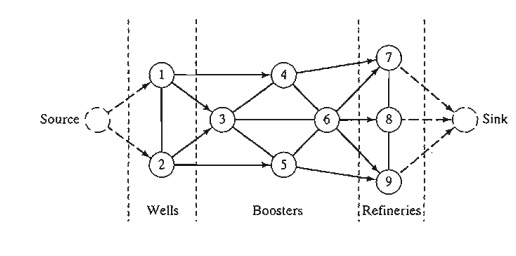
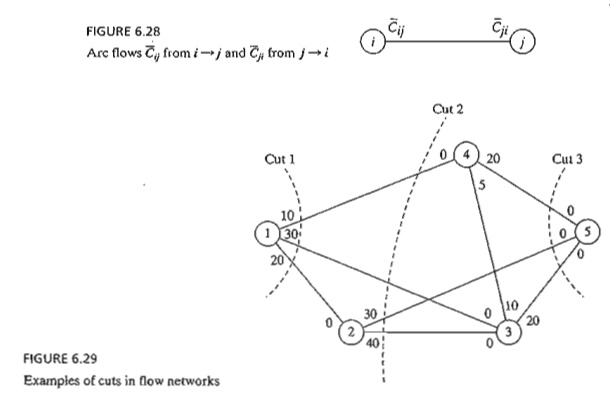
The only
information we can glean from the three cuts is that the maximum flow in the
net-work cannot exceed 60 units. To determine the maximum flow, it is necessary
to enumerate all the cuts, a
difficult task for the general network. Thus, the need for an efficient
algorithm is imperative.
PROBLEM
SET 6.4A
*1. For
the network in Figure 6.29, determine two additional cuts, and find their
capacities.
2. Maximal Flow Algorithm
The
maximal flow algorithm is based on finding breakthrough
paths with net positive flow
between the source and sink nodes. Each path commits part or all of the capaci-
ties of its arcs to the total flow in the network.

For a
node j that
receives flow from node i, we attach a label [ai, i], where aj is the
flow from node i to node j. The steps of the algorithm are
thus summarized as follows.
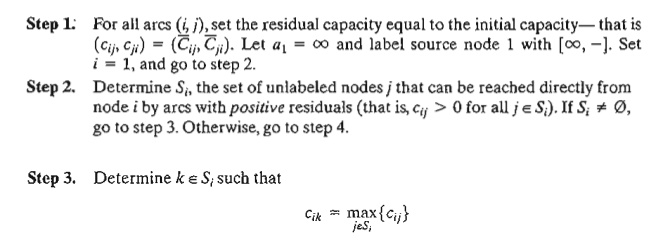
Set ak = cik and label node k with [ak i]. If k = n, the sink
node has been labeled, and a breakthrough
path. is found, go to step 5. Otherwise, set i = k, and go to step 2.
Step 4. (Backtracking). If i = 1, no
breakthrough is possible; go to step 6. Otherwise, let r be the node that has been labeled immediately before current node i and remove i from the
set of nodes adjacent to r. Set i = r, and go to step 2.
Step 5. (Determination ofresiduals). Let Np = (1, k1
k2, .. . , n) define
the nodes of the pth breakthrough
path from source node 1 to sink node n.
Then the max-imum flow along the path is computed as

The
residual capacity of each arc along the breakthrough path is decreased by f p in the direction of the flow and
increased by f p in the
reverse direction-that is, for nodes i and j on the path, the residual flow
is changed from the current (Cij, cji) to

Reinstate
any nodes that were removed in step 4. Set i = 1, and return to step 2 to attempt
a new breakthrough path.
Step 6. (Solution).
(a) Given that m
breakthrough paths have been determined, the maximal flow in the network is

The backtracking process of step 4 is invoked
when the algorithm becomes "deadended" at an intermediate node. The
flow adjustment in step 5 can be explained via the simple flow network in Figure 6.30. Network (a) gives
the first breakthrough path N
l =
{I, 2, 3, 4} with its maximum flow It =
5. Thus, the residuals of each of arcs (1, 2), (2,3), and (3,4) are
changed from (5,0) to (0,5), per step 5. Network (b) now gives the second
breakthrough path N2 = {I, 3, 2, 4} with
f2 = 5. After making the necessary flow
adjustments, we get network (c), where no further breakthroughs are possible.
What happened in the transition from (b) to (c) is nothing but a cancellation
of a previously committed flow in the direction 2 -> 3. The algorithm is
able to "remember" that
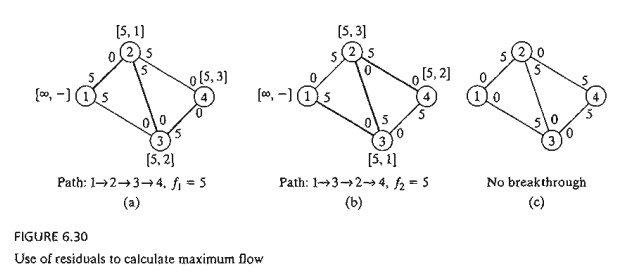
a flow
from 2 to 3 has been committed previously only because we have increased the
capacity in the reverse direction from 0 to 5 (per step 5).
Example
6.4-2
Determine
the maximal flow in the network of Example 6.4-1 (Figure 6.29). Figure 6.31
provides a graphical summary of the iterations of the algorithm. You will find
it helpful to compare the description of the iterations with the graphical
summary.
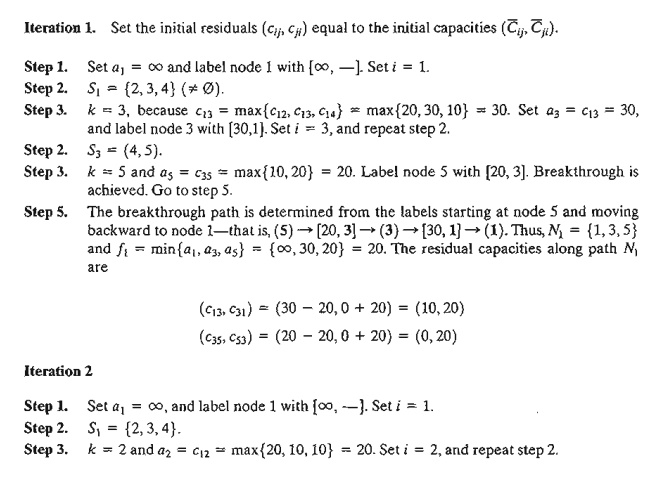
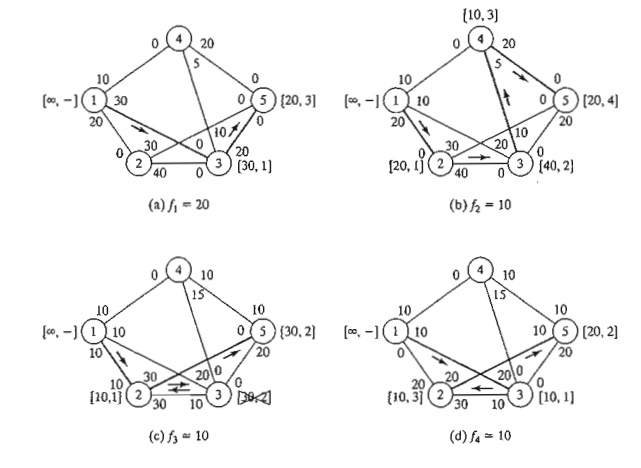
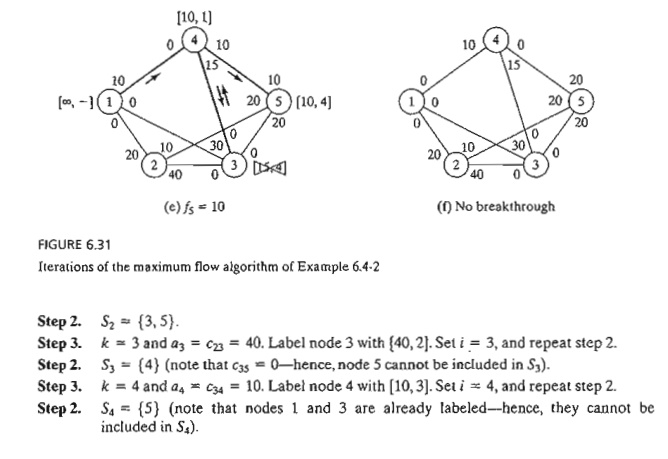
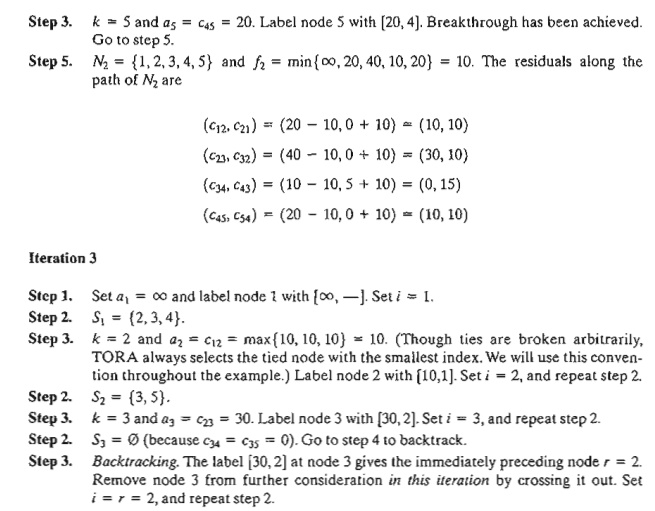
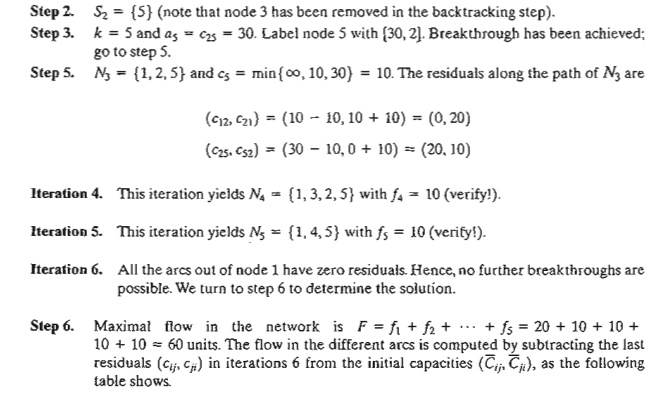
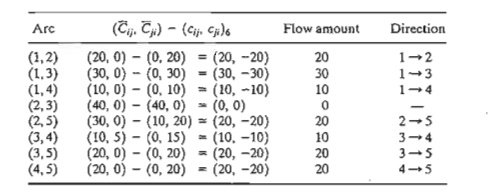
PROBLEM
SET 6.4B
*1. In Example 6.4-2,
a)
Determine the surplus capacities for all the arcs.
b)
Determine the amount of flow through nodes 2,3, and
4.
c)
Can the network flow be increased by increasing the capacities in the
directions 3 -> 5 and 4-> 5?
2. Determine
the maximal flow and the optimum flow in each arc for the network in Figure
6.32.
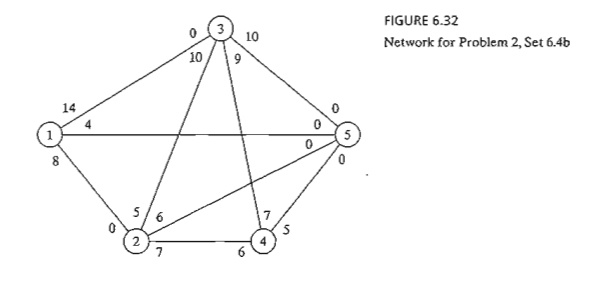
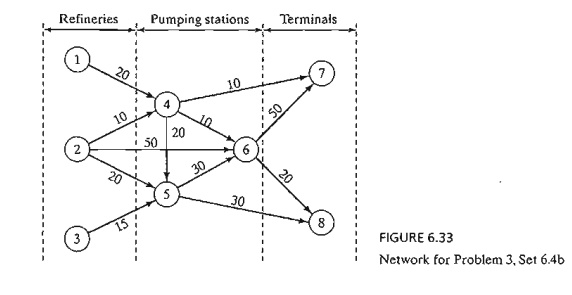
3. Three
refineries send a gasoline product to two distribution terminals through a
pipeline network. Any demand that cannot be satisfied through the network is
acquired from other sources. The pipeline network is served by three pumping
stations, as shown in Figure 6.33. The product flows in the network in the
direction shown by the arrows. The capacity of each pipe segment (shown
directly on the arcs) is in million bbl per day. Determine the following:
i.
The daily production at each refinery that matches
the maximum capacity of the net-work.
ii.
The daily demand at each terminal that matches the
maximum capacity of the net-work.
iii.
The daily capacity of each pump that matches the
maximum capacity of the network.
4. Suppose
that the maximum daily capacity of pump 6 in the network of Figure 6.33 is
lim-ited to 50 million bbl per day. Remodel the network to include this
restriction. Then determine the maximum capacity of the network.
5. Chicken
feed is transported by trucks from three silos to four farms. Some of the silos
can-not ship directly to some of the farms. The capacities of the other routes
are limited by the number of trucks available and the number of trips made
daily. The following table shows the daily amounts of supply at the silos and
demand at the farms (in thousands of pounds). The cell entries of the table
specify the daily capacities of the associated routes.

(a)
Determine the schedule that satisfies the most demand.
(b) Will
the proposed schedule satisfy all the demand at the farms?
6. In
Problem 5, suppose that transshipping is allowed between silos 1 and 2 and
silos 2 and 3. Suppose also that transshipping is allowed between farms 1 and
2,2 and 3, and 3 and 4. The maximum two-way daily capacity on the proposed
transshipping routes is 50 (thousand) lb. What is the effect of transshipping
on the unsatisfied demands at the farms?
*7. A
parent has five (teenage) children and five household chores to assign to them.
Past experience has shown that forcing chores on a child is counterproductive.
With this in mind, the children are asked to list their preferences among the
five chores, as the following table shows:
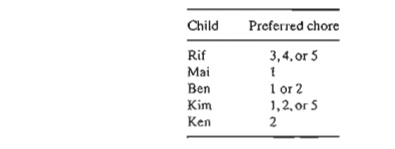
The
parent's modest goal now is to finish as many chores as possible while abiding
by the children's preferences. Determine the maximum number of chores that can
be completed and the assignment of chores to children.
8. Four
factories are engaged in the production of four types of toys. The following
table lists the toys that can be produced by each factory.
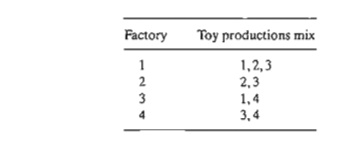
All toys
require approximately the same per-unit labor and material. The daily
capaci-ties of the four factories are 250,180,300, and 100 toys, respectively.
The daily demands for the four toys are 200, 150, 350, and 100 units,
respectively. Determine the factories' production schedules that will most
satisfy the demands for the four toys.
9. The
academic council at the U of A is seeking representation from among six
students who are affiliated with four honor societies. The academic council
representation includes three areas: mathematics, art, and engineering. At most
two students in each area can be on the council. The following table shows the
membership of the six students in the four honor societies:

The
students who are skilled in the areas of mathematics, art, and engineering are
shown in the following table:
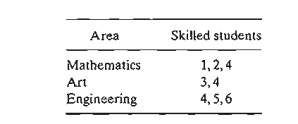
A student
who is skilled in more than one area must be assigned exclusively to one area
only. Can all four honor societies be represented on the council?
10. Maximal/minimal flow in networks with lower
bounds. The maximal flow algorithm given in
this section assumes that all the arcs have zero lower bounds. In some models,
the lower bounds may be strictly positive, and we may be interested in finding
the maximal or minimal flow in the network (see case 6-3 in Appendix E). The
presence of the lower bound poses difficulty because the network may not have a
feasible flow at all. The objective of this exercise is to show that any
maximal and minimal flow model with positive lower bounds can be solved using
two steps.
Step 1.Find an initial feasible solution
for the network with positive lower bounds.
Step 2. Using the feasible solution in
step 1, find the maximal or minimal flow in the original network.
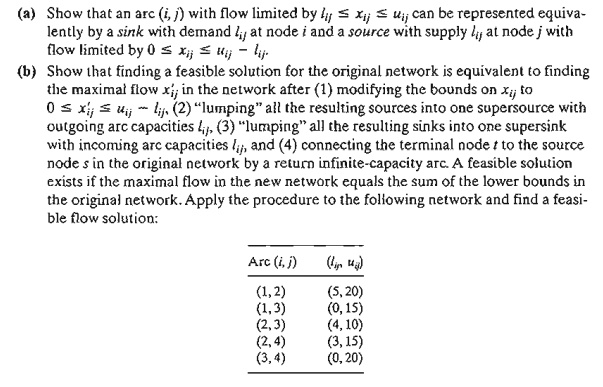
(c) Use
the feasible solution for the network in (b) together with the maximal flow
algorithm to determine the minimal
flow in the original network. (Hint:
First compute the residue network given the initial feasible solution. Next,
determine the maximum flow from the end
node to the start node. This is equivalent to finding the maximum flow that
should be canceled from the start node to the end node. Now, combining the
fea-sible and maximal flow solutions yields the minimal flow in the original
network.)
(d) Use
the feasible solution for the network in (b) together with the maximal flow model to determine the
maximal flow in the original network. (Him: As in part (c), start with the
residue network. Next apply the breakthrough algorithm to the result-ing
residue network exactly as in the regular maximal flow model.)
3. Linear Programming Formulation of Maximal Flow Mode
Define xij as the
amount of flow in arc (i,j) with capacity cij . The
objective is to determine xij for all i and j that
will maximize the flow between start node s and terminal node t subject
to flow restrictions (input flow = output
flow) at all but nodes s and t.
Example
6.4-3
In the
maximal flow model of Figure 6.29 (Example 6.4-2), s = 1 and t = 5. The following table summarizes
the associated LP with two different, but equivalent, objective functions
depending on whether we maximize the output from start node 1 (= z.) or the input to terminal node
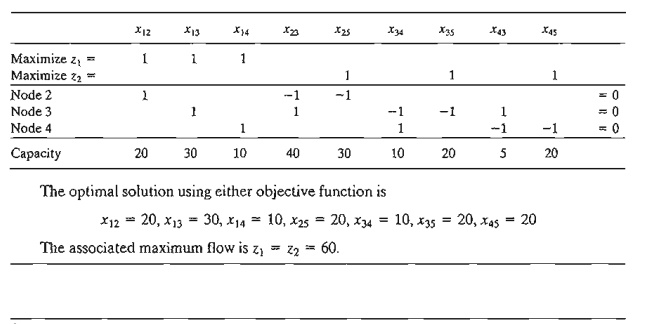
Solver Moment
Figure
6.34 gives the Excel Solver model for the maximum flow model of Example 6.4-2
(file solverEx6.4-2.xls). The general idea of the model is similar to that used
with the shortest-route model, which was detailed following Example 6.3-6. The
main differences are: (1) there are no flow equations for the start node 1 and
end node 5, and (2) the ob-jective is to maximize the total outflow at start
node 1 (F9) or, equivalently, the total in-flow at terminal node 5 (G13). File
solverEx6.4-2.xls uses G13 as the target cell. You are encouraged to execute
the model with F9 as the target cell.
AMPLMoment
Figure
6.35 provides the AMPL model for the maximal flow problem. The data applies to
Example 6.4-2 (file ampIEx6.4-2.txt). The overall idea of determining the input
and output flows at a node is similar to the one detailed following Example
6.3-6 of the shortest-route model (you will find it helpful to review files
amplEx6.3-6a.txt and ampIEx6.3-6b.txt first). However, because the model is
designed to find the maximum flow between any
two nodes, start and end, two additional constraints are needed to ensure that
no flow enters start and no flow Leaves end. Constraints inStart and
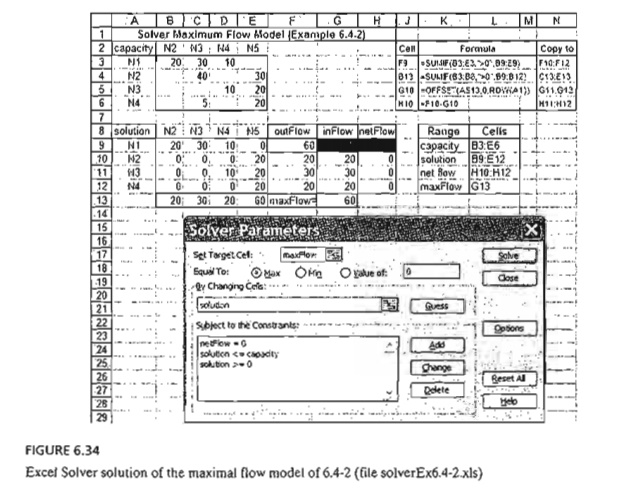
QutEnd in
the model ensure this result. These two constraints are not needed when start=l
and end=5 because the nature of the data guarantees the desired result.
However, for start=3, node 3 allows both input and output flow (arcs 4-3 and
3-4) and, hence, constraint inS tart is needed (try the model without
inStart!).
The
objective function maximizes the sum of the output flow at node start.
Equivalently, we can choose to maximize the sum of the input flow at node end.
The model can find the maximum flow between any two designated start and end
nodes in the network.
PROBLEM
SET 6.4C
1. Model
each of the following problems as a linear program, then solve using Solver and
AMPL.
a.
Problem 2, Set 6.4b.
b.
Problem 5,Set 6.4b
c.
Problem 9, Set 6.4b.
2. Jim
lives in Denver, Colorado, and likes to spend his annual vacation in
Yellowstone National Park in Wyoming. Being a nature lover, Jim tries to drive
a different scenic route each year. After consulting the appropriate maps, Jim
has represented his preferred routes between Denver (D) and Yellowstone (Y) by
the network in Figure 6.36. Nodes 1 through
14 represent intermediate cities. Although driving distance is not an issue,Jim's
stipulation is that selected routes between D and Y do not include any common
cities.
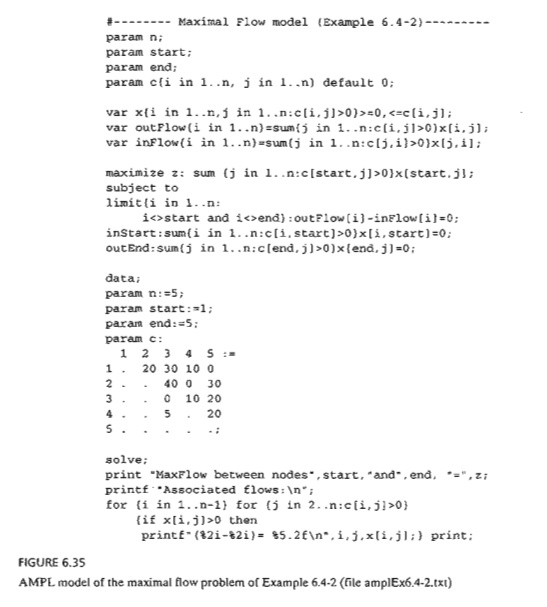
Determine
(using AMPL and Solver) all the distinct routes available to Jim. (Hint: Modify the maximal flow LP model
to determine the maximum number of unique paths between D and Y.)
3. (Gueret
and Associates, 2002, Section 12.1) A military telecommunication system
con-necting 9 sites is given in Figure 6.37. Sites 4 and 7 must continue to
communicate even if as many as three other sites are destroyed by enemy
actions. Does the present communication network meet this requirement? Use AMPL
and Solver to work out the problem.
Related Topics